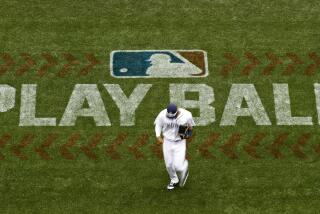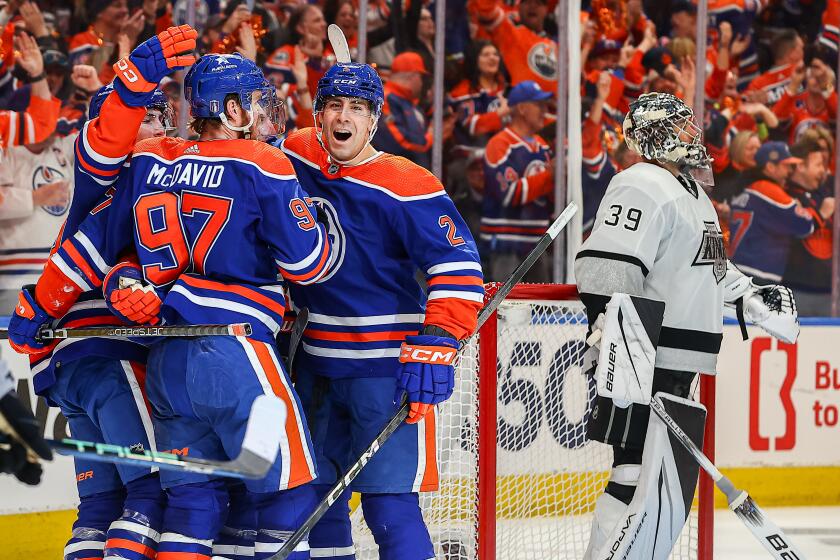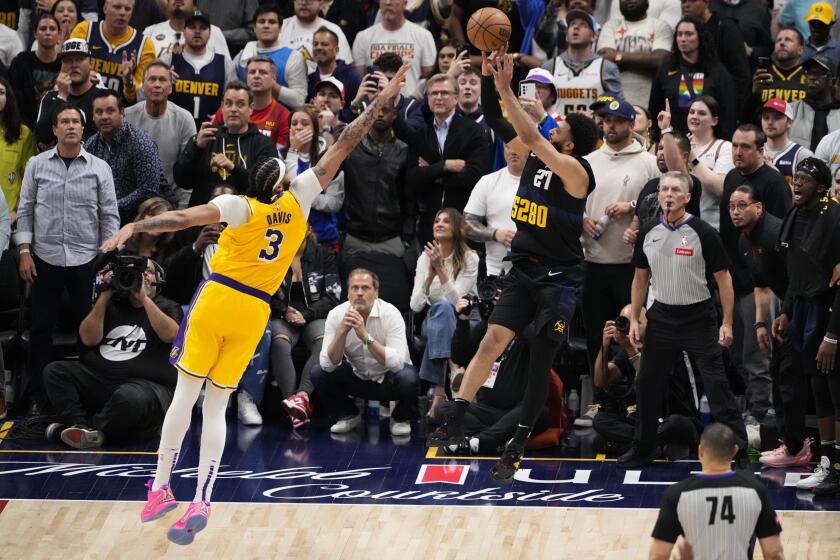They lost big, and not just on field
Twelve professional sports franchises have declared bankruptcy. Following are the cases and the outcomes:
National Hockey League
1975 Pittsburgh Penguins
Cause: Team owners Tad Potter and Peter Block owed the IRS $500,000, and the government intended to get its money. The feds seized tax dollars and even locked the doors of the Civic Arena to send a message to ownership. The team had no choice but to file for bankruptcy when employees couldn’t get into their offices.
Team assets: The team owed $6.5 million, but it was the $500,000 owed to the government that forced its hand.
Outcome: Just as the Penguins looked like they would have to fold or relocate — Seattle was considered a likely destination — a group headed by Albert Savill purchased the team for $3.8 million and kept it in Pittsburgh. The Penguins went on to post a winning record and reach the playoffs that season despite the summer of turmoil.
1978 Cleveland Barons
Cause: The California Golden Seals moved to Cleveland in 1976, but the Barons had trouble attracting fan support. The team drew only 8,900 fans for its first game, and sold fewer tickets than it had in Oakland. Ownership missed payroll twice in the first season, and needed a $1.3-million loan from the league to stay afloat. The Barons filed for bankruptcy and ceased operations, although the team was merged with the Minnesota North Stars.
Team assets: The Barons’ worth in unclear because they were merged rather than being sold. The size of the $1.3-million loan suggests the team was worth at least a few million.
Outcome: The North Stars stayed afloat for 13 years, but by 1991, ownership invested in the expansion San Jose Sharks and was allowed to take half the team with it. The other half went to the relocated North Stars, who moved to Dallas and became the Stars.
1995 L.A. Kings
Cause: Los Angeles has experience with a bankrupt team owner in Bruce McNall. McNall’s free spending helped bring Wayne Gretzky to town, but it also spelled McNall’s fiscal demise. In December 1993, he defaulted on a $90-million loan and the team filed for bankruptcy two years later.
Team assets: The team was sold to its current owners for $113 million after bankruptcy was declared in 1995.
Outcome: McNall was convicted of defrauding multiple banks of more than $200 million. The Kings, meantime, changed ownership twice. McNall sold the team to Joseph Cohen and Jeffrey Sudikoff in May 1994, before current owners Philip Anschutz and Ed Roski purchased the team from the executives for $113 million a year and a half later. The day of the second sale, Cohen and Sudikoff allowed the team to file for bankruptcy so that the sale could proceed. McNall served nearly five years in prison.
1998 Pittsburgh Penguins
Cause: Only six years after winning back-to-back Stanley Cups, the Penguins faced ruin for the second time in 23 years. Team owners Howard Baldwin and Morris Belzberg had overspent and lost an additional $25 million to the 1994 lockout. After they could no longer defer players’ salaries to keep the team stable, the owners declared bankruptcy in October 1998.
Team assets: The Penguins faced about $114 million in debt, $30 million of which it owed to Mario Lemieux.
Outcome: Lemieux’s contract was at the core of ownership’s problems. Lemieux agreed to exchange the money he was owed for part ownership of the team.
2003 Ottawa Senators
Cause: It was a simple matter of fans not filling the seats. The Senators were good, so good that they would end the 2002-03 season just short of the Stanley Cup finals. But the fans weren’t responding, and the team filed for bankruptcy in the middle of the season.
Team assets: The Senators were $160 million (Canadian) in debt before Eugene Melnyk purchased the team from Rob Bryden.
Outcome: In January, the team was momentarily saved by a court decision that granted temporary bankruptcy protection. The move gave the team $13.7 million to pay rent, loans and payroll . . . and most important, the first-place team could keep playing.
2003 Buffalo Sabres
Cause: John Rigas took ownership of the team in 1997, but by 2003 his business, Adelphia Communications, was in trouble. Under Rigas, the Sabres filed for bankruptcy just days before Adelphia did the same, and like Bruce McNall, Rigas faced corruption charges. Rigas and his son Timothy eventually were convicted of conspiracy, bank fraud and securities fraud; John Rigas was sentenced to 15 years in prison.
Team assets: Tom Golisano purchased the struggling Sabres for $92 million after the 2002-03 season.
Outcome: The Sabres struggled under NHL control, and finished 27-37-10-8 — one of the worst records in team history. Two months after the team filed for bankruptcy, the league sold the team to Golisano, preventing the team from moving or folding.
2009 Phoenix Coyotes
Cause: Hockey has been a tough sell in the desert, and the Coyotes’ future remains uncertain. Since the team moved to Glendale, Ariz., from Winnipeg, Canada, in 1996, ownership has incurred losses that now total in the hundreds of millions. In late 2008 it became clear that the team was being operated and funded largely by the NHL.
Team assets: The league bought the team for $140 million in October 2009, and the team remains for sale.
Outcome: To be determined.
Major League Baseball
1970 Seattle Pilots
Cause: In their only season, 1969, the Pilots couldn’t come close to filling their minor league stadium, drawing only 677,000 fans. By the end of the season, the Pilots’ bank accounts had run dry, and they weren’t going to last to see a new stadium without new ownership.
Owner Dewey Soriano first fielded an offer for the Pilots from Bud Selig during the 1969 World Series. Selig planned to move the club to Milwaukee, but the state of Washington filed an injunction to stop the sale in March.
Team assets: Selig’s offer for the Pilots was $10.8 million.
Outcome: To overcome the injunction, the Pilots filed for bankruptcy. When the Pilots’ general manager testified he could not find the money necessary to pay coaches, players or front office personnel, the club was declared bankrupt. The ruling came six days before opening day in 1970. Selig moved the newly named Brewers to Milwaukee for the season, in which they wore old Pilots jerseys. The Brewers finished 1970 with a 65-97 record, finishing fourth in their division.
1993 Baltimore Orioles
Cause: Owner Eli Jacobs started having financial problems in 1991. The following year, most of his stock portfolio vanished amid company reorganizations and stock restructurings. Amidst these hurdles, four lending establishments sued Jacobs for defaulting on loans totaling $36.4 million. Jacobs couldn’t even hold onto his house, as banks foreclosed on his $2-million mansion in Owings Mills, Md.
Team assets: Jacobs’ debts were well past $100 million by the time seven banks filed petitions to force him into bankruptcy.
Outcome: In March 1993, Jacobs gave up control of the Orioles as a Bankruptcy Court prepared to auction the franchise. Peter Angelos led a group of Baltimore investors with the winning bid of $173 million in August. The Orioles finished 1993 with a 85-77 record, good for third place in the American League East.
2009 Chicago Cubs
Cause: The Cubs’ owner, the Tribune Co., which owns the Los Angeles Times, had entered bankruptcy a year earlier but kept the Cubs out of the proceedings to protect the franchise from creditors. When Tribune found a buyer for the Cubs in Joe Ricketts, the club was entered under bankruptcy protection. By entering bankruptcy, the sale was protected from Tribune Co. creditors who hoped to claim the hundreds of millions of dollars the franchise would fetch.
Team assets: Though the Tribune Co. at one point owed $13 billion, the Cubs and related properties were valued at $845 million.
Outcome: Ricketts, the founder of TD Ameritrade, purchased the Cubs, Wrigley Field, 25% of Comcast Sports Net and all related properties for $845 million in October. Tribune retained 5% ownership. The Cubs finished second in the National League Central in 2009 with an 83-78 record.
2010 Texas Rangers
Cause: Team owner Tom Hicks, also the owner of the Dallas Stars hockey team, the Frisco (Texas) Roughriders minor league baseball team and half of English soccer team Liverpool FC, led Hicks Sports Group. After borrowing money from MLB in July 2009, Hicks turned his attention from selling a minority stake in the Rangers to selling the team entirely. Hicks came to an agreement with a group led by Rangers team president and Hall of Fame pitcher Nolan Ryan for $570 million. One of HSG’s lenders disputed the deal, though, arguing it would not pay off all of HSG’s debts.
Team assets: The dispute continued into the 2010 baseball season, and in May the Rangers filed for bankruptcy with an estimated debt of $575 million. Included in that sum was $24.9 million owed to New York Yankees third baseman Alex Rodriguez.
Outcome: An auction in Bankruptcy Court pitted Ryan’s group against a group led by Dallas Mavericks owner Mark Cuban. Ryan came out on top with an offer of $608 million. The Rangers reached the 2010 World Series, where they lost to the San Francisco Giants.
2011 Los Angeles Dodgers
Cause: Court records in the 2009-10 divorce trial of Frank and Jamie McCourt revealed that the couple had diverted more than $100 million from the team for personal use. The primary property in dispute between the now-divorced couple is the Dodgers. By June 2011, Frank McCourt, in danger of failing to meet payroll, files for bankruptcy, and Jamie asserts she owns half the franchise.
Team assets: If Frank McCourt were to receive all of the $150 million short-term loan he has lined up, the debt load would rise to about $775 million.
Outcome: To be determined
More to Read
Get our high school sports newsletter
Prep Rally is devoted to the SoCal high school sports experience, bringing you scores, stories and a behind-the-scenes look at what makes prep sports so popular.
You may occasionally receive promotional content from the Los Angeles Times.







